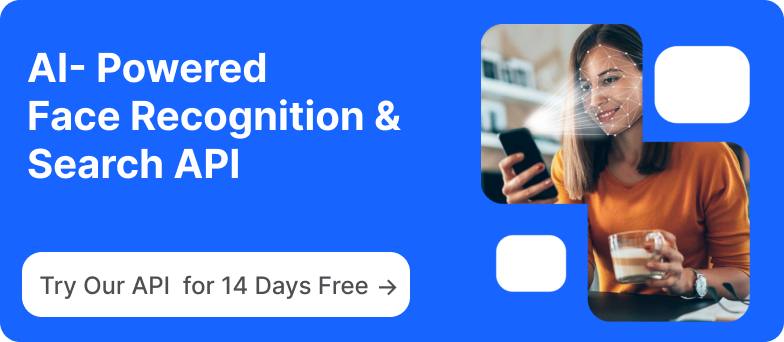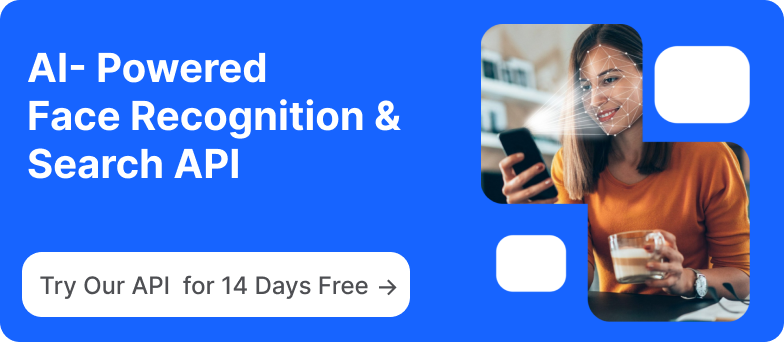
SDK vs. API: Which is Better for Building Your Face Recognition App?
As businesses seek to implement face recognition into their applications, they are often faced with a key decision: should they build their solution using an SDK (Software Development Kit) or an API (Application Programming Interface)?
Both SDKs and APIs provide the means to integrate advanced face recognition capabilities, but they cater to different development needs and goals. While SDKs offer more control, customization, and the ability to run offline, APIs provide easier integration, scalability, and reduced maintenance efforts by leveraging cloud-based services. Choosing the right approach depends on your specific requirements, budget, and project complexity.
In this blog post, we’ll dive deep into the advantages of both SDKs and APIs for building face recognition software. We’ll explore the differences, use cases, and factors to consider so that you can make an informed decision on the best solution for your project.
When building a face recognition app or software, two of the most common tools developers consider are the SDK (Software Development Kit) and the API (Application Programming Interface). While they both enable integration of facial recognition technology, they serve different purposes and suit different project needs. To make an informed decision, it’s important to understand what each tool offers and how they differ.
What is an SDK (Software Development Kit)?

An SDK, or Software Development Kit, is a comprehensive package of tools, libraries, documentation, and code samples that allow developers to build applications for a specific platform or integrate particular features—such as face recognition—into their apps. Think of an SDK as a toolbox that includes everything you need to create or extend a software application. SDKs often include not only the core functionality but also the development environment (IDEs), APIs, and debugging tools to help developers build solutions more efficiently.
For face recognition, an SDK provides all the necessary code, algorithms, and libraries to integrate facial recognition directly into your software. This can give developers more control over the implementation, allowing for customization and optimization according to the app’s specific needs. Additionally, SDKs are often designed to work offline, making them ideal for environments with limited or no internet connectivity.
What is an API (Application Programming Interface)?
An API, or Application Programming Interface, is a set of protocols and definitions that allow different software applications to communicate with each other. In simpler terms, it acts as a bridge between your application and a service provider's backend, allowing you to use their features without needing to build them from scratch. APIs are often cloud-based, meaning they operate through a network (typically the internet), sending and receiving data between your app and the server hosting the facial recognition service.
For developers working on face recognition, an API allows for seamless integration of pre-built recognition capabilities by simply sending an image to a third-party provider and receiving analyzed results—such as detected faces, identified individuals, or emotion tracking. The convenience of APIs is their simplicity and scalability, as developers don’t need to manage complex algorithms themselves.
Key Differences Between SDK and API
While both SDKs and APIs allow you to build and integrate face recognition, they do so in different ways, and each has distinct advantages depending on your project’s goals.
Implementation
An SDK provides a local development environment with tools that are directly embedded into your app. This gives developers full control over how the facial recognition functions within their software.
An API, on the other hand, acts as a service that your application communicates with over the internet, relying on external servers to perform face recognition tasks.
Customization
SDKs allow more customization because the entire set of tools and algorithms are at your disposal, letting you modify features to match your app’s specific needs.
APIs typically offer less flexibility since they provide predefined functionality, which can be limited to the features exposed by the third-party provider.
Connectivity
SDKs usually function offline, making them ideal for applications that need to operate without continuous internet access.
APIs are generally cloud-based and require an internet connection, which may not be ideal for offline or remote use cases.
Maintenance and Updates
With SDKs, the responsibility for updates and maintenance often falls on the developer, as they are handling the software locally.
With APIs, the service provider handles updates and maintenance, ensuring you always have access to the latest version of the technology without needing to worry about manual upgrades.
Learn more here: What is the Difference Between API and SDK?
Use Cases of SDK vs API

Choosing between an SDK (Software Development Kit) and an API (Application Programming Interface) when building a face recognition app largely depends on the specific needs of your project. Each approach comes with its own strengths, and selecting the right one can significantly impact the performance, flexibility, and scalability of your software. Understanding when to use an SDK versus when to rely on an API will help you make the right decision based on your goals and environment.
When to Use an SDK for Face Recognition
An SDK is ideal when you need complete control over how face recognition technology functions within your app. Because an SDK provides a full development toolkit, it allows for more customization and offline functionality. Here are some specific scenarios where using an SDK makes sense:
Offline operation. If your application needs to work without constant internet access—such as in remote areas or on mobile devices without reliable connectivity—an SDK is your best option. Since SDKs can operate fully on local devices, you can integrate face recognition features that work independently of cloud services.
Customization and flexibility. For developers who require advanced control over face recognition algorithms, an SDK is perfect. Whether you need to fine-tune detection parameters, optimize performance, or create highly specialized features, SDKs allow for in-depth customization that APIs may not offer.
On-Premise solutions. In scenarios where data privacy is critical, such as in healthcare, finance, or government projects, you may need to keep everything local to ensure compliance with data protection laws. An SDK allows you to host the face recognition system on your own infrastructure, maintaining complete control over the data without relying on external services.
Performance optimization. If your application demands high-speed processing and minimal latency, an SDK is advantageous. Since all computations happen locally, response times can be faster than cloud-based solutions, making SDKs more suitable for real-time face recognition tasks, such as in security systems or interactive apps.
In these cases, an SDK offers the flexibility and control needed to deliver highly specialized face recognition capabilities.
When to Use an API for Face Recognition
APIs, on the other hand, are a better fit when ease of integration and scalability are top priorities. APIs allow developers to access powerful face recognition features without needing to manage complex algorithms themselves, making them ideal for many cloud-based applications. Below are situations where using an API is more beneficial:
Quick integration and scalability. If you’re looking for a fast and straightforward way to add face recognition to your app, an API is the way to go. APIs are designed for easy integration, enabling you to send images to a server and get results back without having to build or manage the recognition algorithms yourself. This is especially useful for startups or small teams working under time constraints.
Cloud-based applications. When your app is cloud-native or requires continuous internet access, an API is the logical choice. Since APIs work by sending requests to a third-party service, they fit naturally into cloud environments, making them ideal for web-based apps, mobile applications with cloud connectivity, or enterprise solutions that require large-scale data processing.
Lower maintenance burden. APIs are maintained and updated by the service provider, so you don't have to worry about upgrading the software, fixing bugs, or adapting to new technology standards. If you want to offload the responsibility of maintaining the face recognition technology and focus on your core product, an API simplifies this process.
Cost-effective for certain use cases. For applications that only require occasional or moderate use of face recognition, APIs can be more cost-effective than developing and maintaining a full SDK-based solution. With API-based pricing models, such as pay-per-request, you only pay for what you use, making it a financially attractive option for smaller projects or those that don’t demand continuous processing.
Cross-platform integration. APIs can easily be integrated into applications running on various platforms and devices. If you need a face recognition solution that works across web, mobile, and desktop environments with minimal platform-specific development, an API offers the flexibility to implement a unified solution across multiple systems.
In these cases, an API provides a streamlined, scalable solution for implementing face recognition technology without the overhead of local development or maintenance.
Advantages of SDK for Face Recognition

When it comes to building a face recognition app or software, opting for an SDK (Software Development Kit) offers several advantages, especially for developers looking for more control, flexibility, and performance. SDKs allow you to directly integrate face recognition algorithms and tools into your app, giving you a deeper level of customization and management. Let’s explore some of the key benefits of using an SDK for face recognition.
Full Control Over Implementation
One of the biggest advantages of using an SDK is the control it provides over the implementation of face recognition features. With an SDK, you can access the core algorithms, libraries, and source code that power face recognition technology. This means you have complete control over how the system functions within your app.
For developers, this level of control is crucial when creating specialized applications that need unique features or strict compliance with specific requirements. Whether you're fine-tuning the face detection accuracy, modifying how recognition is triggered, or integrating additional sensors, an SDK offers the flexibility to mold the solution to your specific needs. This is particularly valuable for projects where every detail matters, such as in biometric security, healthcare, or retail.
Offline Functionality
Another key advantage of using an SDK is the ability to run face recognition processes offline. Since all the algorithms and resources are packaged within the SDK, your app can operate independently of the internet, processing face recognition tasks directly on the user’s device or on-premises server.
This makes SDKs the preferred choice for environments where reliable internet connectivity may not be available, such as in rural areas, underground facilities, or on devices like drones and security cameras operating in remote locations. Offline functionality also improves security, as sensitive data never leaves the local device, ensuring that all processing is handled in a closed, secure environment. This is ideal for industries where data privacy and security are paramount.
Customization and Flexibility
An SDK gives developers the power to customize face recognition functionality in ways that APIs typically do not. By using an SDK, you can adjust the algorithms to optimize face detection for specific use cases, such as recognizing faces from unusual angles, under various lighting conditions, or when people are wearing masks or glasses.
The flexibility to tailor the technology to your exact requirements is one of the primary reasons businesses opt for SDKs. This allows developers to innovate and build unique features, such as adjusting recognition thresholds, integrating with other hardware (like infrared cameras), or implementing hybrid recognition models combining face, fingerprint, and voice recognition. In industries where differentiation is key, such as in custom apps for security, retail, or entertainment, the ability to adapt the technology to specific conditions gives SDKs a clear edge.
Faster Response Time
Since all processing happens locally with an SDK, face recognition operations can be executed with minimal latency. For real-time applications—like surveillance systems, identity verification kiosks, or interactive installations—SDKs offer a significant speed advantage over cloud-based solutions.
When face recognition algorithms are embedded directly into your app, there’s no need to send data to an external server and wait for a response. This not only speeds up the recognition process but also ensures smoother user experiences, especially in scenarios where fast response times are critical. Whether it's detecting a person at a security checkpoint or allowing quick entry through an automated gate, the ability to perform these tasks instantly is a major benefit of SDK-based implementations.
By choosing an SDK for face recognition, developers gain full control over how the technology functions, with the added advantages of offline capabilities, extensive customization, and faster processing speeds. These factors make SDKs a powerful option for specialized or mission-critical face recognition applications.
Learn more here: Top Face Recognition SDKs in 2024
Advantages of API for Face Recognition

When deciding how to integrate face recognition technology into your app or software, using an API (Application Programming Interface) offers several unique advantages, especially for developers who prioritize ease of use, scalability, and reduced maintenance. By leveraging a face recognition API, you can access powerful facial recognition features via a simple interface without needing to manage the underlying complexities. Let’s explore the key benefits of using an API for face recognition.
Easy Integration and Scalability
One of the greatest strengths of APIs is the simplicity of integration. With an API, developers can add face recognition capabilities to their app by making API calls—sending images to the server and receiving processed data in return. This eliminates the need for building complex facial recognition algorithms from scratch, making it much faster and easier to get your app up and running.
This ease of integration is particularly useful for projects that require a quick turnaround or have limited development resources. You can access a variety of pre-built functions, such as face detection, emotion analysis, and identity verification, through straightforward API requests. This allows you to focus more on the core aspects of your app rather than spending time developing intricate machine learning models.
APIs also offer scalability. Since the processing is handled on the server side, increasing your app's ability to handle more users or data becomes straightforward. You don’t need to worry about scaling your infrastructure as the API provider takes care of it. Whether you have 10 users or 10 million, an API can scale to meet your growing demands seamlessly.
Cloud-Based Solutions
Most face recognition APIs are cloud-based, meaning they operate over the internet by connecting your app to remote servers that handle the heavy lifting of processing and analysis. Cloud-based solutions offer numerous advantages, especially when you need continuous access to powerful computing resources without investing in your own infrastructure.
By relying on the cloud, face recognition tasks such as matching faces against large databases or running complex analytics can be performed without the constraints of local hardware. Cloud-based APIs are ideal for applications that need to operate across multiple platforms—web, mobile, and desktop—since the same API can be used regardless of the underlying system.
Cloud services also offer the benefit of global accessibility. Since the face recognition API is hosted in the cloud, your app can access the service from anywhere in the world, ensuring that users in different regions have the same level of performance and reliability.
Maintenance and Updates Handled by Provider
One of the major advantages of using a face recognition API is that maintenance and updates are handled by the API provider. When you integrate an API, you’re essentially outsourcing the responsibility of maintaining the face recognition technology. This includes handling software updates, bug fixes, and ensuring that the latest advancements in facial recognition are incorporated into the service.
For developers, this removes a significant burden, allowing you to focus on building and enhancing your core application without worrying about the intricacies of maintaining the face recognition component. The API provider ensures that the service is always up to date with the latest security patches, performance improvements, and technology advancements. This is particularly beneficial in fast-evolving fields like face recognition, where staying current with the latest algorithms can be critical.
Cost-Effectiveness for Certain Use Cases
In many cases, using a face recognition API can be more cost-effective than building a full solution in-house, especially for smaller projects or apps with limited facial recognition needs. APIs often operate on a pay-as-you-go model, meaning you only pay for the requests or usage you need, rather than investing in costly infrastructure or software licenses.
For example, if your app only needs to verify a few hundred faces per month, using an API will likely be much cheaper than developing a face recognition system from scratch. You won’t have to spend money on expensive development tools or infrastructure, as the API provider handles all of that for you. This makes APIs an attractive option for startups, small businesses, or companies looking to add face recognition functionality without a significant upfront investment.
Additionally, APIs offer the flexibility to scale up or down depending on usage. If your app’s demand for face recognition increases over time, you can easily scale by paying for additional API requests without needing to overhaul your system.
By choosing an API for face recognition, you gain easy integration, access to cloud-based solutions, minimal maintenance, and cost-effective scalability. These advantages make APIs the perfect choice for many modern applications, especially for projects where rapid deployment, flexibility, and lower costs are key considerations.

Factors to Consider When Choosing Between SDK or API
Deciding whether to use an SDK (Software Development Kit) or an API (Application Programming Interface) for your face recognition app is a critical step in the development process. The choice depends on various factors, including the nature of your project, budget, security concerns, and your preferred deployment environment. To help you make the right decision, here are some key factors to consider.
Project Requirements (Complexity, Time Constraints)
The complexity of your project and how quickly you need to deliver it are two of the most important factors in choosing between an SDK or an API.
If your project is complex and requires extensive customization, such as developing unique features or fine-tuning face recognition algorithms, an SDK may be the better choice. SDKs offer full control over how the technology is implemented, allowing you to modify and optimize the solution to meet your exact needs. However, this also means more development time, as SDKs typically require more effort to integrate and configure.
For projects with tight deadlines or straightforward requirements, an API is often the more practical solution. APIs allow for rapid integration since you’re using a pre-built service that handles face recognition for you. This can be a huge time-saver if your project doesn’t require extensive customization or if you’re working with a small team.
Choosing between the two largely depends on how much control and customization you need versus how quickly you want to launch your app.
Budget and Pricing Models
Your budget plays a significant role in determining whether an SDK or an API is more suitable for your project.
SDKs often come with upfront costs, such as licensing fees or the need for specific hardware and software. If you’re building an on-premise or offline solution, you’ll likely face higher initial development and deployment expenses. However, SDKs can be more cost-effective in the long run if you’re dealing with large volumes of data or require full control over your infrastructure.
APIs, on the other hand, often operate on a pay-as-you-go model. This means you’ll pay based on usage—whether it’s per request or a monthly subscription. This pricing model is usually more affordable for smaller projects or applications with occasional face recognition needs. It’s a great option for startups or businesses that want to keep initial costs low but are comfortable with ongoing expenses tied to usage.
Ultimately, the choice depends on whether you’re looking for a lower upfront investment with APIs or a long-term, self-hosted solution with an SDK.
Security and Privacy Concerns
When dealing with sensitive data, such as biometric information, security and privacy concerns must be a top priority.
An SDK allows you to keep data processing on-premise, giving you full control over your infrastructure and how data is managed. This is crucial for industries such as healthcare, finance, or government, where strict regulations dictate how personal data must be handled. With an SDK, you can ensure that face recognition data is processed and stored locally, without relying on external services or transmitting sensitive information over the internet.
An API typically processes data in the cloud, which means data is sent to a third-party server for analysis. While many API providers implement strong security measures, including encryption and compliance with privacy regulations, the fact that data leaves your environment could be a concern in industries with strict privacy requirements. However, for less regulated industries or applications where security is less of a concern, the convenience of cloud-based processing can outweigh the risks.
Your choice should be guided by how sensitive the data is and what regulations you must comply with.
Deployment Environment (Cloud vs On-Premise)
Another factor to consider is your deployment environment, as it can significantly influence your choice between an SDK or an API.
If your app or system needs to operate in an on-premise environment, such as in closed networks or offline scenarios, an SDK is the way to go. SDKs allow for the full deployment of face recognition capabilities on local machines or private servers, ensuring that all processes occur within your controlled infrastructure. This is ideal for organizations that have strict requirements to avoid external servers or cloud dependencies.
For cloud-based applications, APIs are often more suitable. APIs are inherently designed to function in a cloud environment, making them perfect for web apps, mobile apps, or platforms that need to scale easily across multiple devices and locations. By leveraging cloud resources, APIs offer greater flexibility and easier deployment across global user bases without the need to manage local infrastructure.
Choosing the right deployment environment depends on whether you need on-premise control or cloud-based scalability.
Maintenance and Support
Finally, consider the level of maintenance and support required when choosing between an SDK or an API.
SDKs often place more responsibility on the development team. You’ll need to maintain the face recognition system, handle updates, and troubleshoot any issues that arise. This can be a significant time and resource investment, especially if you’re working on a large-scale project. However, this also means you have full control over when and how updates are applied, which can be important for maintaining stability in mission-critical applications.
APIs shift much of the maintenance burden to the service provider. The API provider is responsible for maintaining the face recognition technology, rolling out updates, and ensuring that the service remains operational. This can be a huge advantage for teams that want to minimize ongoing maintenance efforts and focus on their core product. However, this also means that you’re dependent on the provider’s support and update schedule, which may occasionally cause disruptions or changes to the service.
Consider how much control you need over updates and how much time and resources you can dedicate to ongoing maintenance when making your decision.
Conclusion
When it comes to building a face recognition app or software, deciding between an SDK or an API depends largely on your project’s unique needs and goals. Both options offer powerful solutions for integrating face recognition technology, but each has its own advantages.
If your project requires full control over the implementation, offline functionality, and the ability to deeply customize the recognition process, an SDK is likely the best choice. SDKs are ideal for complex projects where privacy, performance, and flexibility are top priorities, particularly in environments where data security and on-premise deployment are critical.
On the other hand, APIs shine in scenarios where ease of integration, scalability, and reduced maintenance efforts are essential. By opting for an API, you can quickly add face recognition capabilities to your app without the overhead of building and maintaining the technology in-house. APIs are especially well-suited for cloud-based applications, projects with limited development time, and situations where cost-effectiveness is key.
Ultimately, the right choice comes down to your project’s specific requirements—whether you need extensive customization and control, or if quick integration and scalability are more important. By carefully evaluating your goals, budget, and technical constraints, you can select the best solution to build a powerful and efficient face recognition system.
